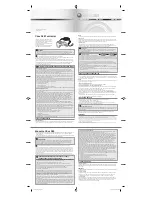
MANUALE TECNICO MT094
TECHNICAL MANUAL MT094
6
La pressione di motorizzazione è ottenuta prelevando
gas dal regolatore alla pressione di monte. Il gas viene
filtrato attraverso il filtro 13 e subisce una prima decom-
pressione nel preriduttore R14/A (fig. 2) composto
essenzialmente da un otturatore 5, da una molla 12 e da
una membrana 10 fino ad un valore Pep che dipende
dalla pressione di taratura del regolatore. Dalla camera
G la pressione Pep passa quindi nel pilota 204/A che
regola tramite l'otturatore 17 fino al valore Pm di immis-
sione nella testata del regolatore. La regolazione di Pm
si ottiene dal confronto tra la forza esercitata dalla molla
di taratura 22 del pilota e l'azione della pressione rego-
lata Pa agente nella camera B sulla membrana 16.
La modifica della taratura viene effettuata ruotando la
vite di regolazione 10; una rotazione in senso orario
provoca un aumento della Pm e quindi della pressione
regolata Pa; viceversa per una rotazione in senso antio-
rario. Se per esempio, durante il funzionamento c'è una
diminuzione di pressione di valle Pa (a causa dell'au-
mento della portata richiesta o della diminuzione della
pressione di monte) si ha uno squilibrio nell'equipaggio
mobile 15 del pilota, che si sposta provocando un
aumento dell'apertura dell'otturatore 17. Aumenta di
conseguenza anche il valore della pressione di motoriz-
zazione Pm, che agendo nella camera E al di sotto della
membrana 15 (fig. 1) determina uno spostamento
verso l'alto dell'otturatore 3 e quindi l'aumento dell'a-
pertura del regolatore fino a ripristinare il valore presta-
bilito della pressione regolata.
Fig. 1
The motorisation pressure is obtained by drawing gas
from gas the regulator at the upstream pressure. The
gas is filtered through the filter 13 and is subjected to
initial decompression in the preregulator R14/A (fig. 2)
composed essentially of an obturator 5, a spring 12
and a diaphragm 10 to a value, Pep, which depends on
the pressure set-point of the regulator. The pressure,
Pep, then passes from the chamber G through the hole
F in the 204/A pilot which adjusts it by means of the
obturator 17 until the inlet value, Pm, in the head of the
regulator. The regulation of Pm is obtained by the com-
parison of the force exerted by the setting spring 22 of
the pilot and the action of the regulated pressure, Pa,
acting in the chamber B on the diaphragm 16.
The set-point can be changed by turning the adjust-
ment screw 10; clockwise rotation increases Pm and
therefore the regulated pressure, Pa; the opposite
occurs when the ring is turned anticlockwise. If, for
example, the downstream pressure, Pa, drops during
operation (because of an increase in the requested flow
rate or a drop in the upstream pressure) an imbalance
occurs in the mobile assembly 15 of the pilot, which is
displaced to increase the opening of the obturator 17.
As a result, the motorisation pressure value, Pm,
increases and, by acting in the chamber E under the
diaphragm 15 (fig. 1), causes the obturator 3 to move
upwards and therefore an increase in the opening of the
regulator until the set-point of the regulated pressure is
restored.
Collegamenti a cura del cliente
Connections to be made by
the customer
N° di riferimento per i collegamenti
Ref. No. for the connections
1
3
1
3
Содержание DIXI AP
Страница 17: ...MANUALE TECNICO MT094 TECHNICAL MANUAL MT094 16 Fig 8...
Страница 37: ...MANUALE TECNICO MT059 TECHNICAL MANUAL MT059 36 PILOTA 204 A R14 A 204 A R14 A PILOT Fig 17...
Страница 50: ...MANUALE TECNICO MT094 TECHNICAL MANUAL MT094 49 NOTE NOTES...
Страница 51: ...MANUALE TECNICO MT094 TECHNICAL MANUAL MT094 50 NOTE NOTES...








































